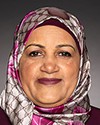Thank you very much, Madam Chair.
Good morning, everyone.
Good morning, everyone.
Even though it's winter, we're very happy to be here with you.
Our intention this morning is to present an overview of the department's responsibilities as well as some information of a technical nature. I know that our minister, the Hon. Marco Mendicino, will have other opportunities to present his priorities and mandate to you.
We are really pleased to be here this morning to present to you some information about the programs in the department.
I'm going to start with slide 3 to give you a bit of an introduction to the department and our responsibilities at Immigration, Citizenship and Refugees Canada.
One of the most important features of Canada's immigration system is the managed migration model. What that really means is that we have legal pathways for permanent and temporary residents, but we also have a plan, and the plan allows us to set levels and manage migration into Canada.
Every year we set a plan that's a rolling three-year model of levels of humanitarian and compassionate grounds, economic immigration and, of course, the family class. We can control the intake of some of those applications, which allows us to prepare and plan and better settle immigrants coming into the country.
We consider as future Canadian citizens all permanent residents who come to Canada and want to settle, and that pathway is really important. We will talk a little bit more about the temporary residents later in the presentation.
It is clear that immigration means more than just facilitating the movement of people. Several elements are linked to it.
First, there's economic development. Given our demographic trends, it is important to have the talent, growth and skills needed not only to fill the gaps in the labour market, but also to grow the economy.
Second, it's about nation-building. Immigration is truly a societal project to enrich the country and diversity, and also to reunite families. Last year, 85,000 people were reunited with their families.
Third, there's the global reach. Globally, the managed approach—which I mentioned earlier—has become a model.
Finally, there are the elements of national security. It's always important to balance openness with the security of the country and Canadians.
Our department is the only federal government department that issues trusted identity documents, such as the permanent resident card.
It's important to note on slide 5 the legal framework that guides the department. You've probably heard a fair amount about the Immigration and Refugee Protection Act, known by its acronym, IRPA. It's a thick tome, not necessarily light reading. It's very technical, very prescriptive, but it's the framework that guides all of the department's actions in organizing immigration to Canada, refugee protection and enforcement.
This act also provides the guidance and the framework for the Immigration and Refugee Board.
We have a Citizenship Act that describes the pathways to citizenship, who can acquire citizenship, how citizenship can be revoked, the proof of citizenship and what is recognized as such.
The Canadian passport order provides direction on how passports can be issued.
The Department of Citizenship and Immigration Act is the enabling legislation for the department. Of course, there is also a huge framework of international law that guides, for example, protected persons and refugees.
All of that, taken together, is the framework that provides direction and guidance to the department.
Turning to slide 6, one of the features that the OECD has noted about Canada's immigration system is that it's nimble and adaptable and able to take into account the challenges of the changing world. One element that we like to think about is that the system works as a continuum, from the decision to migrate or Canada's decisions on selection all the way through to settlement and ultimately a pathway to citizenship.
The system is evidence-based. What we mean by that is that we collect performance data on programs and our activities. The data allows us to further undertake research and undertake evaluation. We use the information to allow the programs and the policies to continuously improve and also to adapt.
Continuous improvement is obvious, but it's important for a few reasons. One is that Canada's immigration system needs to adapt to changing migration patterns globally. We're certainly seeing more and more people on the move. Some of this movement is due to economic migration, but it is also due to the deteriorating state around the world and rogue states and people fleeing violence.
Not only do we wish or need to adapt to changing migration patterns. We're also looking at the changing economic patterns and at what skills and competencies can support Canada's economy, but also the changing expectations of citizens as technology improves and people's expectations for client service and quality change. The department is attuned to those things as well.
Next is slide 7. Here, there are really two main pathways that we think about in coming to Canada.
The first is that of the temporary residents; that is, the range of visitors. There are people who are coming as tourists or for business purposes or to visit family. The second group is international students. We're seeing the number of students increase. More and more students are wanting to come to Canadian universities and colleges to study. The category of temporary foreign workers is really a mixed range. We have those highly skilled in IT, engineers and agricultural workers. There is a real range of skills and competencies that fit the needs of the Canadian economy and labour market.
The second pathway includes the permanent residents. These are people who wish to come to Canada to settle. A large percentage of our permanent residents, about 80%, will ultimately seek citizenship. That demonstrates a real attachment to Canada.
Permanent residents come in three categories as well: the economic immigrants—people who wish to work and contribute in that way to Canada's labour market and economy—spouses and family members, people who are joining economic immigrants or permanent residents or Canadian citizens who are already here; and of course refugees and protected persons who are needing protection and a safe harbour in Canada to start a new life.
For a little bit more information, we'll dive a little deeper into who the temporary residents are. Regarding visitors, the majority—these are business travellers or tourists—are allowed to stay for six months. Unless otherwise specified, temporary visitors require a visa or an electronic travel authorization to come to the country.
Students hold study permits. If you're coming from abroad, you require a study permit, which is normally aligned with the designated learning institution in Canada. It's the provinces that designate their learning institution. The student can amend the permit if they decide their program of study isn't for them and they decide to change schools.
If you are a student with a study permit, you are able to work part time in Canada, and there are different hours, whether you're working on campus or off campus.
Work permits for temporary foreign workers and others are tied normally to a particular employer, but we also have open permits that allow holders of such permits permission to work in Canada and the flexibility often to work in the same sector but perhaps through a different employer.
Even though temporary residents are temporary in nature, they have rights in Canada. They are protected by the Canadian Charter of Rights and Freedoms and they have access to some government benefits and programs.
On slide 9, we dive a little deeper into the subject of permanent residents. As you can see from the pie chart, more than half of the permanent residents—shown by the blue, yellow and green pieces of the pie—are economic immigrants. However, not all of these people are economic immigrants per se, because the economic immigrant would be the principal applicant and they are able to bring their immediate family with them. That accounts for those three slices of the pie.
The next largest piece of the pie is the family reunification, in purple, representing 27%. In 2019, there were over 91,000 admissions in the family class. This is a combination of spouses and children, but also parents and grandparents. Canada is one of the few countries that has a parent and grandparent reunification class.
The last two slices are in grey and in black, representing the refugees and the protected persons, as well as the humanitarian and compassionate class. The humanitarian and compassionate class is a very narrow slice that's used in very unique situations, normally when someone is otherwise inadmissible, but for humanitarian and compassionate grounds, that is waived.
The proportions of the pie have held largely consistent over the years, and this is fairly typical, except I would note between 2015 and 2017, when, due to Operation Syria, the refugee category expanded when Canada resettled over 26,000 Syrian refugees.
I mentioned already the immigration levels plan, which we describe in slide 10. The Immigration and Refugee Protection Act requires that the minister table an annual report in Parliament, part of which is the immigration levels plan. In 2017, the minister began a three-year rolling plan, which we have found to be a more effective way to prepare the country for our managed migration and to plan and organize our settlement services and our own operations. Everybody is transparent and everybody in the country knows what the plan is going forward.
The annual plan is normally tabled in the fall, by November. However, with the election this past year and the new Parliament, the plan will be tabled by mid-March, so you can expect that soon.
In the immigration levels plan, the government sets targets for economic immigration, for family reunification and for resettled refugees and protected persons. That helps us plan and prepare, as noted, for settlement in our operations.
On slide 11, there's a bit more about some of the programs that support those categories of permanent residents. In the economic category, there are a number of programs that target specific needs, such as the federal skilled workers program and the federal business immigration programs.
There are also a number of pilots that the government has launched: a target geographic or sectoral immigration pilot to spread the benefits of immigration beyond, for example, Canada's largest cities, or pilots to address particular needs and sectors—for example, the agricultural pilot.
As for the family category, I've already noted the two pathways there: the spouses and partners and children, and then the parents and grandparents.
As to the protected persons and refugees, we have a few classes of refugees. There are the government-assisted refugees, who are selected, normally from overseas camps, by the UNHCR and come to Canada as permanent residents.
The second class is something that I think Canada is quite proud of internationally. It's the class of privately sponsored refugees, whereby groups of Canadians sponsor refugees to come to Canada. This was really a sign of Canadians wanting to help. This program has been in place for over 40 years.
The blended visa office-referred refugees, which is a very unintuitive name, come under a blended program, which is a combination of government sponsorship and private sponsorship. These refugees are normally complex cases referred by the UNHCR.
I spoke earlier about the humanitarian and compassionate grounds.
I'll now turn to my colleague, Fraser Valentine, who will provide a little bit more information on settlement.




